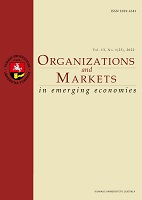Analyzing Exchange Market Pressure Dynamics with Markov Regime Switching: The Case of Turkey
Analyzing Exchange Market Pressure Dynamics with Markov Regime Switching: The Case of Turkey
Author(s): Ali Ilhan, Coşkun Akdeniz, Metin OzdemirSubject(s): National Economy, Supranational / Global Economy, Political economy, Financial Markets
Published by: Vilniaus Universiteto Leidykla
Keywords: capital flows; exchange rate; exchange market pressure; macroeconomic fundamentals; managed floating exchange rate regime; Markov regime switching; Turkey;
Summary/Abstract: This study analyzes the dynamics of exchange market pressure in Turkey by employing the Markov regime switching model for the period from January 2006 to December 2019. Our findings show that there are two regimes in the foreign exchange market, characterized as low- and high-pressure periods. The domination of the high-pressure regime in the sample period indicates that depreciation pressure prevails in the Turkish foreign exchange market. During this regime, the pressure is aggravated by the rising inflation, credit growth, and VIX, and the falling of short-term external debt. Thus, in the presence of capital flows, the preferences of policy authorities regarding price stability and growth determine the course of the pressure. When these policy choices favor credit-driven growth, depreciation pressure in the foreign exchange market is exacerbated through the current account deficit.
Journal: Organizations and Markets in Emerging Economies
- Issue Year: 13/2022
- Issue No: 1
- Page Range: 238-259
- Page Count: 22
- Language: English

